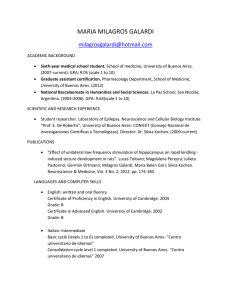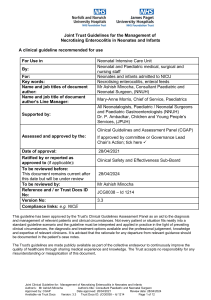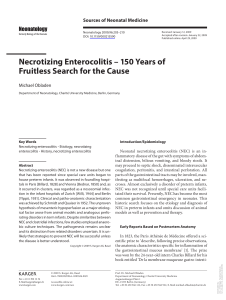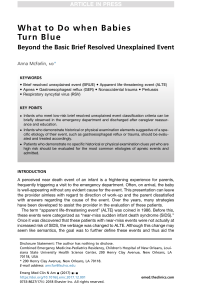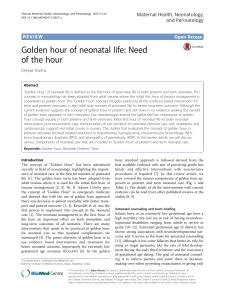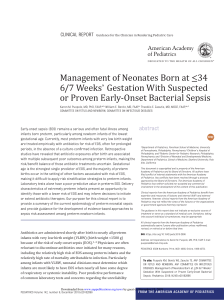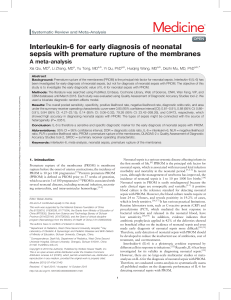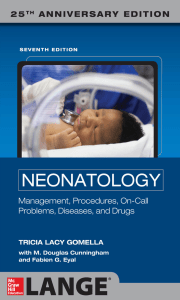Morbidity and mortality in very low birth weight infants
Anuncio
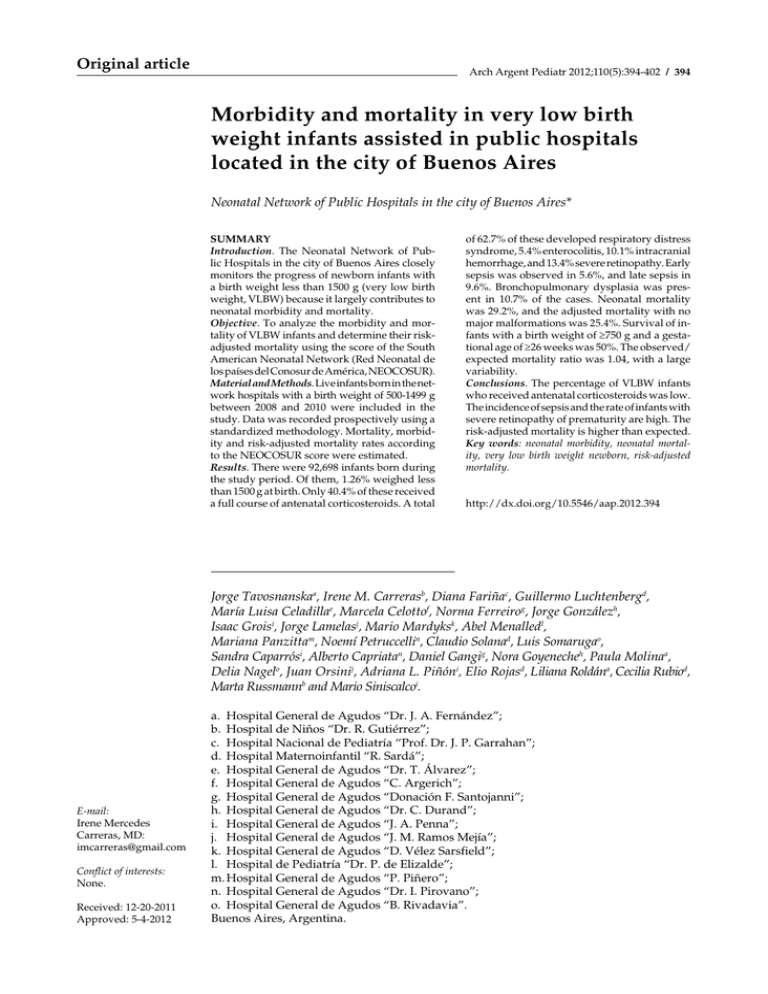
Original article Arch Argent Pediatr 2012;110(5):394-402 / 394 Morbidity and mortality in very low birth weight infants assisted in public hospitals located in the city of Buenos Aires Neonatal Network of Public Hospitals in the city of Buenos Aires* SUMMARY Introduction. The Neonatal Network of Public Hospitals in the city of Buenos Aires closely monitors the progress of newborn infants with a birth weight less than 1500 g (very low birth weight, VLBW) because it largely contributes to neonatal morbidity and mortality. Objective. To analyze the morbidity and mortality of VLBW infants and determine their riskadjusted mortality using the score of the South American Neonatal Network (Red Neonatal de los países del Conosur de América, NEOCOSUR). Material and Methods. Live infants born in the network hospitals with a birth weight of 500-1499 g between 2008 and 2010 were included in the study. Data was recorded prospectively using a standardized methodology. Mortality, morbidity and risk-adjusted mortality rates according to the NEOCOSUR score were estimated. Results. There were 92,698 infants born during the study period. Of them, 1.26% weighed less than 1500 g at birth. Only 40.4% of these received a full course of antenatal corticosteroids. A total of 62.7% of these developed respiratory distress syndrome, 5.4% enterocolitis, 10.1% intracranial hemorrhage, and 13.4% severe retinopathy. Early sepsis was observed in 5.6%, and late sepsis in 9.6%. Bronchopulmonary dysplasia was present in 10.7% of the cases. Neonatal mortality was 29.2%, and the adjusted mortality with no major malformations was 25.4%. Survival of infants with a birth weight of ≥750 g and a gestational age of ≥26 weeks was 50%. The observed/ expected mortality ratio was 1.04, with a large variability. Conclusions. The percentage of VLBW infants who received antenatal corticosteroids was low. The incidence of sepsis and the rate of infants with severe retinopathy of prematurity are high. The risk-adjusted mortality is higher than expected. Key words: neonatal morbidity, neonatal mortality, very low birth weight newborn, risk-adjusted mortality. http://dx.doi.org/10.5546/aap.2012.394 Jorge Tavosnanskaa, Irene M. Carrerasb, Diana Fariñac, Guillermo Luchtenbergd, María Luisa Celadillae, Marcela Celottof, Norma Ferreirog, Jorge Gonzálezh, Isaac Groisi, Jorge Lamelasj, Mario Mardyksk, Abel Menalledl, Mariana Panzittam, Noemí Petruccellin, Claudio Solanad, Luis Somarugao, Sandra Caparrósi, Alberto Capriatan, Daniel Gangig, Nora Goyenecheh, Paula Molinaa, Delia Nagelo, Juan Orsinij, Adriana L. Piñóni, Elio Rojasd, Liliana Roldána, Cecilia Rubiod, Marta Russmannb and Mario Siniscalcoi. E-mail: Irene Mercedes Carreras, MD: imcarreras@gmail.com Conflict of interests: None. Received: 12-20-2011 Approved: 5-4-2012 a. Hospital General de Agudos “Dr. J. A. Fernández”; b. Hospital de Niños “Dr. R. Gutiérrez”; c. Hospital Nacional de Pediatría “Prof. Dr. J. P. Garrahan”; d. Hospital Maternoinfantil “R. Sardá”; e. Hospital General de Agudos “Dr. T. Álvarez”; f. Hospital General de Agudos “C. Argerich”; g. Hospital General de Agudos “Donación F. Santojanni”; h. Hospital General de Agudos “Dr. C. Durand”; i. Hospital General de Agudos “J. A. Penna”; j. Hospital General de Agudos “J. M. Ramos Mejía”; k. Hospital General de Agudos “D. Vélez Sarsfield”; l. Hospital de Pediatría “Dr. P. de Elizalde”; m. Hospital General de Agudos “P. Piñero”; n. Hospital General de Agudos “Dr. I. Pirovano”; o. Hospital General de Agudos “B. Rivadavia”. Buenos Aires, Argentina. Morbidity and mortality in very low birth weight infants assisted in public hospitals located in the city of Buenos Aires / 395 INTRODUCTION Infant mortality is one of the main indicators of healthcare quality. The continuous surveillance of this indicator is a useful tool to assess the outcome, intervene in a timely manner, adjust unwanted de-viations, set up priorities, and adapt procedures and techniques. Annually, approximately 30,000 infants are born in public maternity hospitals in the city of Buenos Aires. Of them, 1.26% weigh less than 1500 g.1 Though very low birth weight (VLBW) infants represent a small group of newborns, they account for 54% of neonatal mortality, require longer length of stay in the hospital, are one of the leading causes of disability, and result in a very high cost of care. All these characteristics, in addition to strategies that have a positive impact on infants’ progress, turn this group into one that requires close surveillance. Birth weight, however, is not the only determining factor of neonatal mortality; hence, it is necessary to standardize results by means of scores based on multiple factors that would allow to predict a risk-adjusted mortality index. In the city of Buenos Aires, there are 11 community maternity centers located in general hospitals, 1 mother and child hospital and 3 neonatal intensive care units in children’s hospitals that are part of the Neonatal Network of Public Hospitals in the city of Buenos Aires. They are grouped in 4 healthcare regions, with a remarkable concentration in two of them, where 75% of VLBW infants are assisted. Up to this moment, there is not a classification based on the level of hospital complexity; consequently, newborn infant care is not organized by regions. Since 2007, the network has been closely monitoring VLBW infants’ morbidity and mortality. To this aim, the network systematically gathers information about morbidity and mortality on an ongoing basis, compares findings to similar standards and proposes changes to improve morbidity and mortality. In this study findings gathered in the last three years are described and analyzed. OBJECTIVES 1. To analyze morbidity and mortality of VLBW infants born in public hospitals that are part of the Neonatal Network of Public Hospitals in the city of Buenos Aires. 2. To assess the risk-adjusted mortality using the NEOCOSUR neonatal network index. MATERIAL AND METHODS This was an observational, descriptive, prospective study conducted within the context of the surveillance of morbidity and mortality of VLBW infants in the public sector of the city of Buenos Aires during 2008-2010. All live newborn infants (NBIs) with a birth weight of 500-1499 g born between January 1st, 2008 through December 31st, 2010 and registered in the network database (BDN 1.2) were included. Data anonymously collected from medical records were entered in each hospital’s database at the time of patient’s discharge and then, after a thorough review, they were submitted for processing on an Excel datasheet. Data was validated, checked and sent back so that missing data were filled in. Observed outcomes Maternal outcomes: age in years, gestational age in weeks by date of last menstrual period, number of visits, condition, antenatal corticosteroids (at least one dose), type of delivery. Neonatal-fetal outcomes: weight at birth and at discharge, gestational age, Apgar score, use of surfactants, major malformations, cause of death, autopsy. Morbidity indicators: presence of respiratory distress syndrome (RDS); bronchopulmonary dysplasia (BPD) defined as supplemental oxygen requirement during at least 28 days at 36 weeks of age; patent ductus arteriosus (PDA) with an echocardiographic diameter over 1.5 mm; clinically suspected sepsis confirmed by blood culture or cerebrospinal fluid culture before (early) or after (late) 72 hours of age; stage II A or higher necrotizing enterocolitis (NEC) according to Bell’s staging criteria;2 grade III or higher intracranial hemorrhage (ICH) diagnosed by ultrasound or at autopsy; grade III or higher retinopathy of prematurity (ROP), considered a “plus” disease and/or requiring laser treatment. Discharge status outcome: dead or alive; morbidity; oxygen requirement; and type of feeding. Continuous outcomes were expressed using the mean and standard deviation values, or the median, and minimum and maximum values. Categorical outcomes are expressed in n and in percentages. Annual specific, overall and malformation adjusted mortality rates were obtained immediately after birth, early or late as defined by the WHO,3 as well as the annual incidence of morbidity outcomes. With the aim to evaluate overall mortality, newborn infants referred to children’s hospitals that were part of the neonatal network were included. To analyze mortality per weight 396 / Arch Argent Pediatr 2012;110(5):394-402 / Original article class, ranges of 250 g were used with inclusive limits of 500 g to 1499 g. To define the causes of death, the criteria used was that of a single leading cause of death. Infants born at <25 weeks of gestation and/or with a birth weight of <750 g were defined as extremely premature infants. Expected mortality was established using the NEOCOSUR* score, which estimates death likelihood of a VLBW infant based on the following parameters: birth weight, gestational age, Apgar score at 1 minute after birth, life threatening congenital malformations, use of prenatal corticosteroids, and sex. The score is obtained by comparing the expected mortality to the observed mortality, estimating their ratio. A score higher than 1 means that it exceeds the expected figure and a score lower than 1 means that it is inferior.4 To evaluate the NEOCOSUR score, and according to its baseline development, no patients referred to children’s hospitals were included. They account for 6.2% of the population. The statistical analysis was conducted using the software EPI Info version 3.3.2. Ethical and legal issues The study was performed in compliance with health authorities and in the context of the morbidity and mortality surveillance of VLBW infants, implemented by the network, a healthcare and epidemiological approach that is not subjected to procedures developed to protect subjects that participate in studies.5 The network database collects dissociated and anonymous data, and adheres to the Argentine Act 25,326 regarding personal data protection (sections 8 and 11).6 RESULTS During the study period, 92,698 infants were born in public hospitals of the city of Buenos Aires. Of them, 1.26% weighed <1500 g at birth. Out of them, 1157 (99%) infants were recorded. * The NEOCOSUR risk score assigns, at the time of birth, the likelihood that a VLBW infant dies during hospital stay, based on the following data: birth weight, gestational age, Apgar score at 1 minute after birth, life-threatening congenital malformations, prenatal corticosteroid administration, and female sex. The sum of the probability of death of each individual results in the probability of death of a patient population. These six factors are statistically significant and arise from the application of a multiple logistic regression model with a stepwise procedure. The score is not adequate for individual use. Table 1 shows the main characteristics of the population. Table 2 shows annual morbidity and mortality rates. Neither birth weight group distribution nor gestational age distribution had a significant variation. The neonatal mortality rate was 29.2%, and the adjusted mortality rate, excluding malformations incompatible with life, was a 4% lower; both rates remained stable over the study period. Survival rate evolution per birth weight and gestational age includes the group of infants referred to other hospitals. It was observed that, as of a weight of 750 g or a gestational age of 26 weeks, the survival rate is close to 50%. With a birth weight over 1000 g, the survival rate is higher than 80%. Most deaths occurred during the first week of age. Figure 1 shows the risk-adjusted mortality index according to the NEOCOSUR score and indicates that the observed mortality is slightly higher than the expected mortality, with a great variability among medical facilities, as described in Figure 2. It was observed that medical facility B, with the biggest number of patients, has a favorable result, only exceeded by medical facility L, with the lowest number of patients. Table 1. Overall characteristics of newborn infants with a birth weight of less than 1500 g, born in the public hospital network of the city of Buenos Aires (2008-2010) Total VLBW infants, n Newborn infants recorded, n, (%) Maternal age (years), mean (SD) Maternal age (years), median (maximum, minimum) No control of pregnancy, n, % 2-3 visits during pregnancy, n, % Multiple pregnancy (2-3 fetuses), n, % Intrauterine growth restriction, n, % Complete course of antenatal corticosteroids Incomplete course of antenatal corticosteroids Birth weight, mean (SD) Gestational age, mean (SD) Male sex, n (%) Apgar at 1st minute ≤4, n (%) Infants born by caesarean section, n, (%) Malformations incompatible with life, n (%) Major malformations, n (%) 1169 1157 99.0 26 (7) 22 425 669 171 257 467 141 1073 29 579 267 940 60 117 (46-13) 38.1 60 15.5 25.8 40.4 12.2 (295) (4.4) 50.0 23.1 81.2 5.2 10.1 Morbidity and mortality in very low birth weight infants assisted in public hospitals located in the city of Buenos Aires / 397 DISCUSSION The assessment of healthcare based on the surveillance of mortality indicators is not enough because the aim is that newborn infants are discharged alive and also that they survive with minor consequences or no consequences at all. This approach requires to monitor other outcome variables in addition to mortality, carry out infants’ Table 3 shows a comparison of our results with those of NEOCOSUR.7,8 Extremely premature infants and RDS were the most common causes of death (35% and 32%, respectively). Sepsis accounts for 19% and major congenital malformations account for 14%. Causes of death per age at death are shown in Figure 3. Table 2. Annual morbidity and mortality of newborn infants with a birth weight of less than 1500 g Total NBIs, n Weight, mean (SD) Gestational age, mean (SD) Newborn infants recorded, n, (%) Survivors, n (%) Newborn infants referred to other hospitals, n, (%) Male sex, n (%) Apgar at 1st minute ≤4, n (%) Infants born by caesarean section, n, (%) Malformations incompatible with life, n (%) Major malformations, n (%) 2008 409 (296) (4.4) 97.1 68.9 7.1 54.4 23.4 83.9 4.0 10.3 1070 29 397 282 28 216 93 333 16 41 2009 2010 Total 08/10 374 1079 (285) 29 (3.2) 374 100.0 253 67.6 22 5.9 194 51.9 95 25.4 299 79.9 19 5.1 36 9.6 386 1097 (286) 29 (3.2) 386 100.0 259 67.1 22 5.7 169 43.8 79 20.5 308 79.8 25 6.5 40 10.4 1169 1073 (295) 29 (4.4) 1157 99.0 794 67.9 72 6.2 579 50.0 267 23.1 940 81.2 60 5.2 117 10.1 Mortality n %n % n %n % Overall mortality 127 31.1121 32.4 127 32.9375 32.1 Neonatal mortality (NM) 114 27.9 117 31.3 117 30.3 341 29.2 Early NM 83 20.3 8522.7 9424.4 26222.4 Death in delivery room 17 4.2 19 5.1 14 3.6 50 4.3 Late NM 31 7.6 328.6 236.0 1089.2 NM with no malformations incompatible with life 98 25.0 98 27.6 92 25.5 281 25.4 Post-natal mortality 133.2 41.1 102.6 34 2.9 NM per birth weight group (%) 500-749 g 60/76 78.9 41/56 73.2 50/59 84.7 151/191 79.1 750-999 g 39/90 43.3 93/93 44.1 38/77 49.4 118/260 45.4 1000-1249 g 16/10016.0 29/9430.9 23/99 23.2 68/293 23.2 1250-1499 g 12/143 8.4 10/131 7.6 16/151 10.6 38/425 8.9 NM per GA group in weeks (%) 20-24 weeks 21/21 100.0 6/7 85.7 20/23 87.0 47/51 92.2 25-28 weeks 48/118 40.7 54/13440.3 52/12342.3 154/37541.1 29-32 weeks 15/160 9.4 26/148 17.6 18/148 12.2 59/456 12.9 33-36 weeks 5/59 8.5 4/49 8.2 4/57 7.0 13/165 7.9 Morbidity Complete course of antenatal corticosteroids Incomplete course of antenatal corticosteroids RDS NEC Early sepsis Late sepsis Grade III/IV ICH Retinopathy* with laser treatment requirement BPD, Mild Moderate Severe n %n % n %n % 165 41.6 147 39.3 155 40.2 467 40.4 46 11.6 41 11.0 54 14.0 141 12.2 238 59.9249 66.6 238 61.7725 62.7 20 5.022 5.9 20 5.262 5.4 16 4.0 10 2.7 39 10.1 65 5.6 27 6.8 15 4.0 69 17.9 111 9.6 44 10.8 36 9.6 38 9.8 118 10.1 32 11.3 48 19.0 26 10.0 106 13.4 16 5.714 5.5 14 5.444 4.0 26 9.3 29 11.5 8 3.11 63 5.7 24 8.515 5.9 16 6.255 5.0 *: percentage of survivors with grade III or IV ROP or with plus disease. 398 / Arch Argent Pediatr 2012;110(5):394-402 / Original article follow-up, record data, and measure mid- and long-term results. The review of records organized in databases provides accurate information to identify processes and difficulties that need to be improved, in order to facilitate the decision making and strategic planning of improvement processes.9 The creation of neonatal care networks enables the implementation of strategies to improve quality.10,11 The Neonatal Network of Public Hospitals in the city of Buenos Aires was created to meet the need to find mechanisms to improve neonatal care through the collaboration among its members. Its primary objectives are: to assess the situation of Figure 1. Annual risk-adjusted mortality of newborns with a birth weight of less than 1500 g in public hospitals in the city of Buenos Aires (2008-2010) References: O/E mortality: observed/expected mortality according to NEOCOSUR score; CI: confidence interval. Figure 2. Risk-adjusted mortality of newborn infants with a birth weight of less than 1500 g in public hospitals of the city of Buenos Aires per medical facility (2008-2010) References: L, B, E, H, G, K, D, C, F, A, J: Hospitals participating in the Neonatal Network of Buenos Aires. O/E: ratio between the number of observed deaths and number of expected deaths according to the NEOCOSUR score; CI: confidence interval. Morbidity and mortality in very low birth weight infants assisted in public hospitals located in the city of Buenos Aires / 399 neonatal care, improve records, develop and maintain a database, report results, update guidelines for care and provide recommendations targeted at reducing neonatal morbidity and mortality. In this context, the priority of the network is to publish its results and compare them to those of other networks with similar population characteristics, such as NEOCOSUR. The comparison (Table 2) indicates that both populations share basic characteristics. However, in infants born within the studied network the use of corticosteroids was lower and a c-section rate was higher. RDS had an incidence of 65.4%, which was lower than that of NEOCOSUR (73.3%),12 in spite of the less frequent use of corticosteroids. It has been widely shown that the antenatal use of corticosteroids reduces the risk of RDS and the use of resources.13,14 In our population, however, the percentage that received a complete course of corticosteroids remains at 40.4%, a rate lower than that of other networks.15,16 This difference might be related to under-recording. Table 3. Morbidity and mortality rates of newborn infants with a birth weight of less than 1500 g in the Neonatal Network of Public Hospitals in the city of Buenos Aires compared to those of NEOCOSUR Period Total (n) NBIs recorded (n) Weight in grams (mean, SD) GA in weeks (mean, SD) Female sex (%) Apgar score <4 at 1st min (%) Complete course of antenatal corticosteroids (%) Birth by cesarean section (%) Apgar lower than 4 at 1st min (%) Deaths; % (n) Overall neonatal mortality with no FSP (%) Death in the delivery room (%) Buenos Aires NEOCOSUR 2008/102001/91 1169 10,258 1157 10,447 1073 (± 295) 1086 (± 279) 29 (± 4.4) 29 (± 3) 49.7 48.8 23.1 22.9 40.4 74.0 81.2 68.7 23.1 22.9 30.5 (357) 21.8 (2230) 23.4 21.5 4.5 3.4 62.7 10.2 11.9 14.1 13.4 5.6 9.6 71.3 10.6 11.1 24.6 5.9 3.8 19.3 Mortality per weight group (%) 500-750 g 750-1000 g 1000-1250 g 1250-1500 g 2008/10 78.5 40.8 18.8 5.9 2008/92 71.1 30.8 15.4 7.9 Mortality per GA group (%) 20-24 weeks 25-28 weeks 29-32 weeks 33-36 weeks 2008/102008/93 92.2 84.7 41.1 32.6 12.9 9.8 7.9 11.0 Morbidity Respiratory distress syndrome (%) Grade III-IV intracranial hemorrhage (%) Necrotizing enterocolitis (%) Bronchopulmonary dysplasia (%) Grade III-IV retinopathy (%) Early sepsis (%) Late sepsis (%) References: NBIs: newborn infants; GA: gestational age. Buenos Aires: Buenos Aires group. Sources: - D’apremont I, Tapia JL, Villarroel L. and Neocosur Collaborative Group. 10 años de funcionamiento de una red sudamericana. Resultados perinatales. Resumen del IV Congreso Chileno de Neonatología. Santiago de Chile, October 2010. Available at: http://sistemas.med.puc.cl/neocosur/ingles/neocosur.asp. - Grandi C, Rojas E, Solana C, Larguía M. Estadísticas Neocosur, Hospital Materno Infantil “Ramón Sardá”, 2009. Rev Hosp Mat Inf Ramón Sardá 2010: 29(4)171-177. - Grandi C, Rojas E, Solana C, Larguía M. Estadísticas Neocosur, Hospital Materno Infantil “Ramón Sardá”, 2010. Rev Hosp Mat Inf Ramón Sardá 2011;30(4)176-180. 400 / Arch Argent Pediatr 2012;110(5):394-402 / Original article Although more immature groups have a lower survival rate, the number of children with severe ROP was high (13.4%), and well above to that of NEOCOSUR (5.9%). This is likely related to the availability of healthcare resources, both technical and human. Among the other studied outcome variables, the lower rate of BPD and late sepsis should be pointed out, which is consistent with the lower rate of neonatal survival in small and immature infants. It is a known fact that there are great differences in sepsis rates from the different neonatal networks and among different hospitals. In this network, the rate of sepsis apparently increased during the follow-up period, reaching 10.1% (early sepsis) and 18% (late sepsis) in the last period, probably due to under-recording. If we consider that infants who died during the first week of age were not excluded, this percentage is high. The sum of both factors leads to working on the management of this severe situation which, additionally, is the cause of death in 20% of infants who died. In order to improve these results, it might be necessary to be determined and to disseminate practices with sound and widely proven benefits.17-19 Neonatal mortality of VLBW infants in hospitals in the city of Buenos Aires is higher than that of NEOCOSUR in all weight and gestational age groups, except in the ranges of 1250-1499 g and 33-36 weeks, and is lower than the percentages reported by the Ministry of Health for the entire country (39.9% and 42% in 2006 and 2010, respectively).20,21 Birth weight is a major determining factor of neonatal mortality, but does not explain its great variability. Medlock has recently conducted a revision of mortality prediction models for VLBW infants. Medlock concluded that multivariate models may offer a better prediction than birth weight or gestational age alone, although it is necessary to conduct additional research with validation and impact studies.22 The NEOCOSUR network developed a relatively simple model to predict death in VLBW infants, that was selected to estimate the risk-adjusted mortality in this study. It was observed that nosocomial mortality in VLBW infants in public hospitals in the city of Buenos Aires is 4% higher than expected, with great variability among medical facilities (Figure 2). The study identified hospitals with a low number of patients with mortality lower than ex- Figure 3. Causes of death of infants with a birth weight of less than 1500 g in public hospitals in the city of Buenos Aires, according to the age at death (2008-2010) References: Early NM: early neonatal mortality; late NM: late neonatal mortality; Post-natal M: post-natal mortality;. Morbidity and mortality in very low birth weight infants assisted in public hospitals located in the city of Buenos Aires / 401 pected, and hospitals with a high number of patients with mortality higher than expected. This is consistent with the study conducted by the Vermont Oxford Neonatal Network,9 published by Rogowsky in 2006. In this study, the conclusion was that indirect quality indicators, such as the number of patients, are not adequate predictors of mortality, and that direct indicators, which are based in outcome measures, are much more reliable. In addition, the study emphasizes the importance of developing databases that allow gathering detailed information about the processes and results, and of identifying and reporting those that result beneficial. The gap noted when comparing our results with those obtained by other networks remains a great challenge for public policies in this area. Some of the determining factors of unfavorable results in the studied group are: population social and economic factors (poverty, education, access to healthcare), healthcare-related factors (resources and their distribution), and factors related to the health team (number, training and attitude). Of these, the leading factors are nurse staffing deficits23-25 and the absence of a region-oriented framework that favors resource improvement and equality for this vulnerable group of infants.26,27 In relation to the first factor, Hamilton (United Kingdom) proved that risk-adjusted neonatal mortality was not related to the size or type of the care unit, but to the availability of specialized nurses. A higher number of specialized nurses taking care of premature infants reduces risk-adjusted neonatal mortality.23 The NEOCOSUR collaborative group has recently published a study showing that neonatal results are associated with the activity and level of professionals, specially nurses and assistants.26 Lack of this resource in Argentina is a well-known issue, and should become a priority for health public policies. Increasing the number of specialized nurses in neonatal intensive care units may enhance survival of premature infants or very low birth weight infants. In relation to the second factor, the network promoted the approval by the Ministry of Health of Resolution 1137. This resolution established, in July 2011, the regionalization of neonatal care for VLBW infants in public hospitals in the city of Buenos Aires, set the following hospitals as points of reference: “Cosme Argerich“, “Carlos Durand“, “Juan A. Fernández“, “Donación Santojanni“ and “Ramón Sardá“, and approved the referral procedure for labor when it occurs before reaching 32 weeks of gestation.28 This last item is yet to be implemented given the low number of nurse staff to cover the quota required by the resolution. It is expected that this resolution will reduce the inequality undergone by very low birth weight infants when they are born in a hospital that may have better o worse results. Efforts should also be directed towards changing attitudes and practice according to the resources provided by scientific evidence, which include social-economic improvement and parent’s education,29 regionalization of healthcare, including neonatal and perinatal care, adequate control of pregnancy, an appropriate number of qualified human resources, adequate care during labor and for the newborn, correct resuscitation measures, timely provision of intensive care, and humanized assistance.30 This is a challenge for creativity and for the actions of all the members in the network and of the health authorities in order to obtain better results through the implementation of healthcare policies and models that will overcome the limitations found by previous policies, which had intrinsic weaknesses. CONCLUSIONS • Neonatal mortality during the study period was 29.2%. • Sepsis is the cause of death in 20% of cases. • The percentage of VLBW infants that received a complete course of corticosteroids is low; however, RDS occurred in 62% of the cases. • The incidence of sepsis and the rate of infants with severe ROP are high. • Risk-adjusted nosocomial mortality is 4% higher than expected, and presents great variability among the different medical facilities in the network. Acknowledgements To the Technical Department of Hospital Materno Infantil “Ramón Sardá” for their help with IT, to Dr. Marina Brussa for her collaboration in retinopathy of prematurity surveillance, to Dr. Celia Lomuto and Prof. Dr. Miguel Larguía for their valuable input and feedback, and for reviewing the draft. n BIBLIOGRAPHY 1. Gobierno de la Ciudad Autónoma de Buenos Aires. Dirección General de Estadística y Censos. Banco de datos. Estadísticas vitales. [Accessed on: July 10, 2011]. Available at: http://www.buenosaires.gob.ar/areas/hacienda/ sisestadisti-co/areastematicas/salud/saludmort.php. 402 / Arch Argent Pediatr 2012;110(5):394-402 / Original article 2. Walsh MC, Kliegman RM. Necrotizing enterocolitis: Treatment based on staging criteria. Pediatric Clin North Am 1986;33:179-201. 3. World Health Organization (WHO): International Statistical Classification of Diseases and Related Health Problems (rev. 10, vols. 1-2;ICD-10). Geneva, WHO; 1992. 4. Marshall G, Tapia JL, D´Apremont I, Grandi C, et al, for GrupoColaborativo NEOCOSUR. A new score for predicting neonatal very low birth-weight mortality risk in the NEOCOSUR South American Network. J Perinatol 2005;25(9):577-82. 5. Council for International Organizations of Medical Sciences (CIOMS). Pautas Internacion-ales para la Evaluación Ética de los Estudios Epidemiológicos. Ginebra; 1991. 6. Ley nº 25326 de Protección de los Datos Personales. Sanción: 04/10/2000; Promulgación: 30/10/2000; Boletín Oficial 02/11/2000. [Accessed on: May 28, 2012]. Available at http://test.e-legis-ar.msal.gov.ar/leisref/public/search. php. 7. D’Apremont I, Tapia JL, Villarroel L y Grupo Colaborativo NEOCOSUR. 10 Años de funcionamiento de una red sudamericana: resultados perinatales. IV Congreso Chileno de Neonatología. [Accessed on: September 20, 2011]. Available at: http://sistemas.med.puc.cl/NEOCOSUR/ DESCRIPCION/Abstracts/10%20anos%NEOCOSUR%20 AbstractCongNEO2010.pdf. 8. D´Apremont I, Tapia JL, Quezada M, Gederlini A, et al. NEOCOSUR: Informe Anual 2008. RevHosp Mat Inf Ramón Sardá2008;27(4):176-9. 9. Rogowski JA, Horbar JD, Staiger DO, Kenny M, et al. Indirect vs. direct hospital quality indicators for very lowbirthweight infants. JAMA 2004;291:202-9. 10. Martines J, Paul VK, Bhutta Z, Koblinsky M, et al, for the Lancet Neonatal Survival Steering Team. Neonatal survival: a call for action. Lancet 2005;365:1189-97. 11. González R, Merialdi M, Lincetto O, Lauer J, et al. Reduction in neonatal mortality in Chile between 1990 and 2000. Pediatrics 2006;117:949-54. 12. Fehlmann E, Tapia JL, Fernández R, Bancalari A, et al, for Grupo Colaborativo NEOCOSUR. Impacto del síndrome de dificultad respiratoria en recién nacidos de muy bajo peso de nacimiento: estudio multicéntrico sudamericano. Arch Argent Pediatr 2010;108(5):393-400. 13.Crowley P. Prophylactic corticosteroids for preterm birth. Cochrane Database of Systematic Reviews. En: The Cochrane Library, Issue 08, Art. No. CD000065. DOI: 10.1002/14651858.CD000065.pub1. [Accessed on: October 10, 2011]. Available at: http://cochrane.bvsalud.org /cochrane/main.php?lib=COC&searchExp=Prophylactic%20 and%20corticosteroids&lang=es. 14. Onland W, de Laat MW, Mol BW, Offringa M. Effects of antenatal corticosteroids given prior to 26 weeks’ gestation: a systematic review of randomized controlled trials. Am J Perinatol 2011;28(1):33-44. 15. EuroNeoNet Annual Report for VLGAI 2006. [Accessed on: September 27, 2011]. Available at: http://www.euroneonet.eu/paginas/publicas/euroneo/euroNeoNet/ Documents/InformeanualEuroneonet2006.pdf. 16. Fanaroff AA, Stoll BJ, Wright LL, Carlo WA, et al. NICHD. Neonatal Research-Network. Trends in neonatal morbidity and mortality for very low birthweight infants. Am J Ob-stetGynecol2007;196:147.e1-147. 17. Payne NR, Finkelstein MJ, Liu M, Kaempf JW, et al. NICU practices and outcomes associated with 9 years of quality improvement collaboratives. Pediatrics 2010;125(3):437-46. 18. Atwater A, Hartmann E, Brown B, Carteaux P, el al. Evaluation and development of potentially better practices for staffing in neonatal intensive care units. Pediatrics 2006;118(Suppl 2):S134-40. 19. Horbar JD, Plsek PE, Leahy K, Schriefer J. Evidence-based quality improvement in neonatal and perinatal medicine: The NIC/Q 2002 Experience. Pediatrics 2006;118(Suppl 2):S57-20. 20. Lomuto C. Situación de la salud perinatal. República Argentina. 2006. RevHosp Mat Inf Ramón Sardá 2008;27(3):12833. 21. Ministerio de Salud de la Nación. Dirección de Estadísticas e Información en Salud. EstadísticasVitales. 2006. [Accessed on: September 20, 2011]. Available at: http://www. deis.gov.ar. 22. Medlock S, Ravelli ACJ, Tamminga P, Mol BWM, AbuHanna A. 2011. Prediction of mortality in very premature infants: a systematic review of prediction models. PLOSONE6(9):e23441.doi:10.1371/journal.pone.0023441. [Accessed on: October 10, 2011]. Available at: http://www. plosone.org/article/info%3Adoi%2F10.1371%2Fjournal. pone.0023441. 23. Hamilton KE, Redshaw ME, Tarnow-Mordi W. Nurse staffing in relation to risk-adjusted mortality in neonatal care. Arch Dis Child Fetal Neonatal Ed 2007;92:F99-F103. 24.A prospective evaluation of risk-adjusted outcomes of neonatal intensive care in relation to volume, staffing and workload in UK neonatal intensive care units - UK Neonatal Staffing Group Study–British Asociation of Perinatal Medicine. Nov 2000. [Accessed on: October 23, 2011]. Available at http://www.bapm.org/publications/documents/general/UKNNS4bap m. pdf. 25. Grandi C, González A, Meritano J y Grupo colaborativo NEOCOSUR. Riesgo de morbimorta-lidad neonatal de recién nacidos menores de 1500 g asociado al volumen de pacientes, personal médico y de enfermería: una investigación multicéntrica latinoamericana. Arch Argent Pediatr 2010;108(6):499-510. 26. De Mucio B, Fescina R, Schwarcz A. Regionalización de la atención perinatal. Buenos Aires: Ministerio de Salud de la Nación. Organización Panamericana de la Salud (OPS/ OMS); 2011. 27. Lasswell SM, Barfield WD, Rochat RW, Blackmon L. Perinatal regionalization for very low-birth-weight and very pre-term infants: a meta-analysis. JAMA 2010;304(9):9921000. 28. Anexos del Boletín Oficial n° 3708. Ministerio de Salud. Resolución Nº 1137/GCABA/MSGC/11. Buenos Aires; 14-julio-2011. 29. Bartels DB, Kreienbrock L, Dammann O, Wenzlaff P, Poets CF. Population-based study on the outcome of small for gestational age newborns. Arch Dis Child Fetal Neonatal Ed 2005;90:F53-F59. 30. Warner B, Musial, MJ, Chenier T, Donovan E. The effect of birth hospital type on the outcome of very low birth weight infants. Pediatrics 2004;113:35-41.
